|
The second generation of King Regula cameras had a redesigned camera body. It was thinner and had a new top housing with an elevated section with view or rangefinder and extension meter, if present. All models had wind levers with a frame counter dial. The rewind knob had an integrated film reminder or distance meter for the uncoupled rangefinder models. Model names and serial numbers were no longer engraved on metal inlays inside the camera but were printed instead. The wind mechanism still featured the 'Regula chain'.
The naming of the models was loosely based on the first generation. There were three viewfinder models, the Regula IP.a, IP.o and IIa, which had similar specifications as the Regula I-P, I-Po and II from the first series, respectively. Two uncoupled rangefinder models were called the Regula ID and IID. There was also a coupled rangefinder called the Regula Cita.
Several changes were made during production of the series II Regulas, which are summarised at the end of this page, after introducing the individual models.
King Regula IP.a
The King Regula IP.a had Prontor-SV or SVS shutters, a Steinheil Cassar 45mm f/2.8 lens and a viewfinder with an extinction meter. Extinction meters were simple devices to estimate exposure: when looking through the eye piece one would see an increasing series of numbers, the highest number visible would indicate the exposure value. This value needed to be translated to shutter and aperture settings with a table, they were not indicated on the shutter and did not match light-values used on common light meters. This method was not very accurate as the sensitivity of the human eye depends on the brightness of the surroundings.
Quite a few different variants of the I.Pa existed, but the basic specifications did not change, as the differences were largely cosmetic. Variations included the lens base, the markings on the top housing and the King Regula logo on the front.

Rare first version of the King Regula IP.a with engraved top plate and a characteristic lens base with multiple rings. These were only produced for a short time, all with serial# in the 60,000 range.

A slightly later version of the King Regula IP.a that still had the ribbled lens base, but already had an embossed top plate and black lens ring. It must have been made for a very short while only.
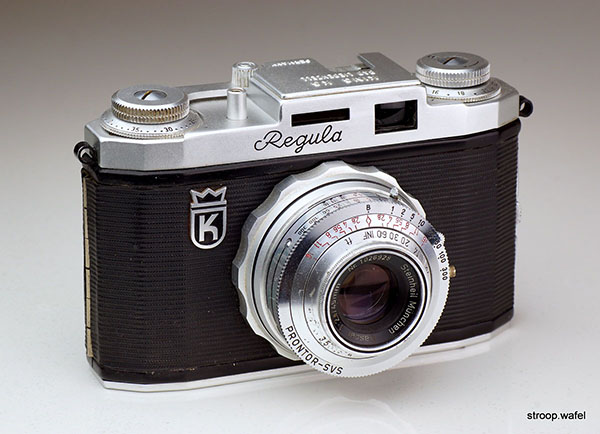
A more common version of the King Regula IP.a with embossed top plate, a King emblem on the front, King Regula engraved below the extinction meter window and a characteristic corrugated lens base.
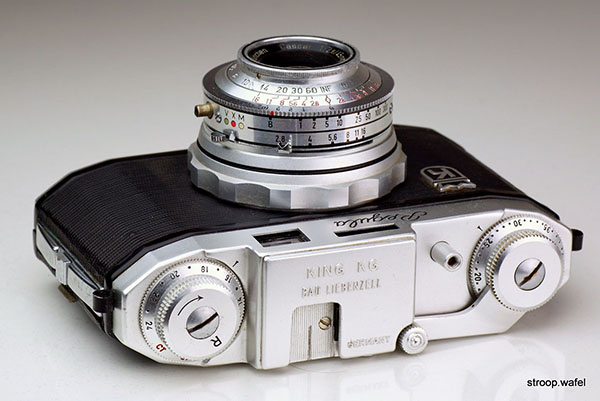
Top view of a King Regula IP.a. There were at least three main variants of markings on the top housing, all of which can be found on different IP.a's.

A later version of a King Regula IP.a (based on body serial #). This variant has engraved markings on its top housing, but no longer 'Regula' engraved on the front.

A rather unusual version of the King Regula IP.a with a lens style typical of the King Regula III series. The top housing also differs, it is the same as the Cita shown below, and the name King Regula is not engraved on the front. The body is covered in leather instead of the normal herringbone plastic covering.
King Regula IP.o
The King Regula IP.o had a Pronto shutter and Cassar 45mm f/2.8 lens. Whereas both the Regula IIa and IP.a were produced in different variants, the IP.o appears to be produced only for a short time as the version with the lens base composed of concentric rings, like the early Regula IP.a. There is an identical looking IIa but with a Regulon lens and an identical looking IP.a but with Prontor-SV shutter. The IP.o was probably phased out because it was too similar to the two other models.

A King Regula IP.o with its characteristic lens base.
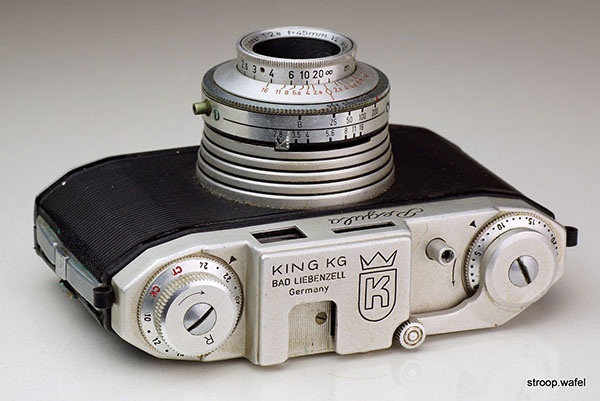
Top view of a King Regula IP.o showing the King emblem engraved on top of the camera.

A later, slightly different version of the King Regula IP.o with an embossed top plate. Note it has a Regula logo at the front, presumably added as it was no longer engraved in the top. These features were similar to the second version of the IP.a above, but before the new corrugated lens base had been introduced.
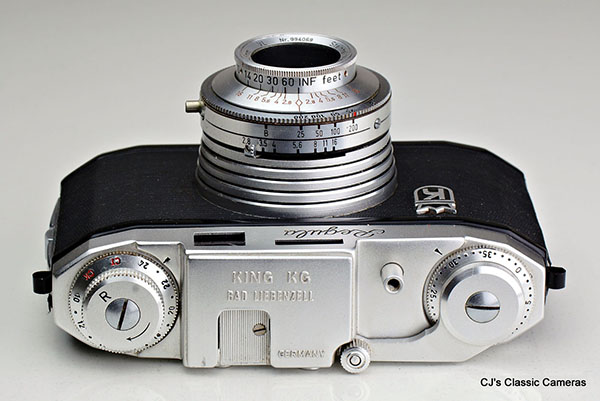
Top view of the later version of the King Regula IP.o with embossed top plate and ribbled lens base, a rather uncommon combination.
King Regula IIa
The King Regula IIa was similar to the IP.a, but came with a Pronto shutter and most had a unusually wide angle (for a standard lens) 40mm f/3.5 Cassar lens, like the first example below. Most had an extinction meter, but a version with only a viewfinder located in the middle of the top housing existed also. Like the IP.a, the IIa can be found with several different top housings and lens bases. In the US this model was sold as the 'Duke'.
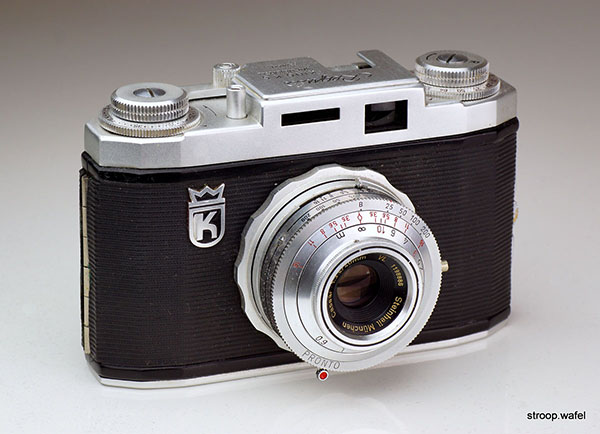
A King Regula IIa with 40mm f/3.5 Cassar lens. It had no King Regula logo engraved on the front. The engravings on the top housing are the same as on the Cita below.
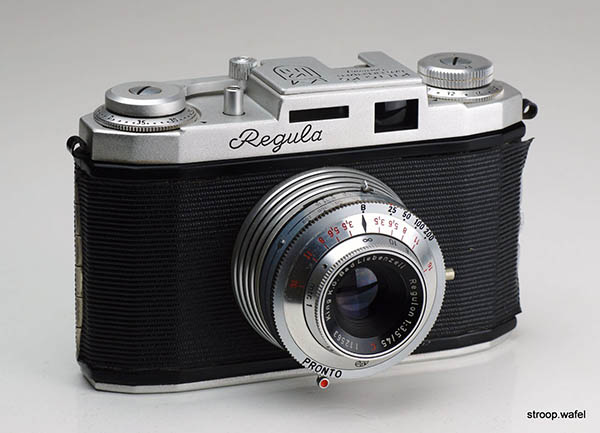
A rather rare early version of the King Regula IIa, which could easily be confused with a Regula IP.o shown earlier on this page. The only difference appears to be the lens, which was a King Regulon 45mm f/3.5 on this model.
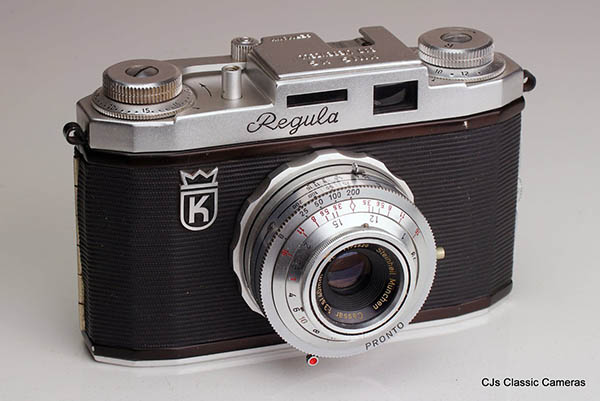
A slightly later version with embossed top and Steinheil Cassar lens.

Near the end of production, the King Regula IIa was equipped with a more normal, slighter narrower lens, a Cassar 45mm f/3.5.
King Regula Cita
The King Regula Cita had a coupled rangefinder and helical focussing, so the characteristic ring on the lens base served as the focus ring. The name Cita was engraved between the viewfinder and rangefinder windows. As the relatively high price already indicated, the Cita was regarded the top model of the second generation. There was also a celebratory gold version in red leather, the Citalux 300 (see below). In the US the Cita was sold as Gipsy. On the inside the camera is not marked Cita but K8.
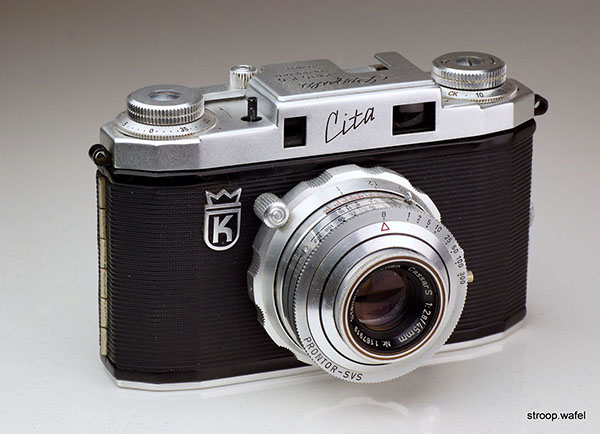
A King Regula Cita with coupled rangefinder. It looks like I forgot to put the metal shutter release button back on after cleaning the rangefinder.
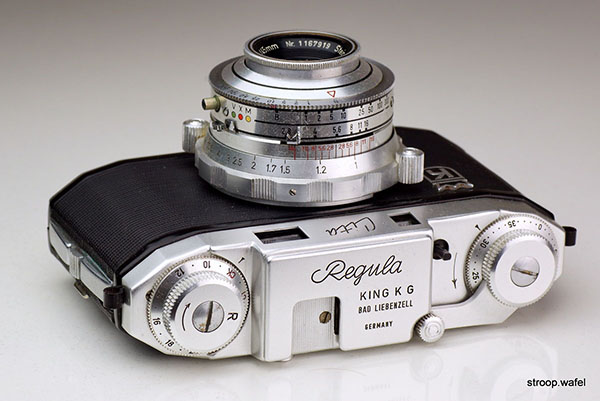
Top view of a King Regula Cita, this style top engraving is the most common amongst second generation King Regulas.
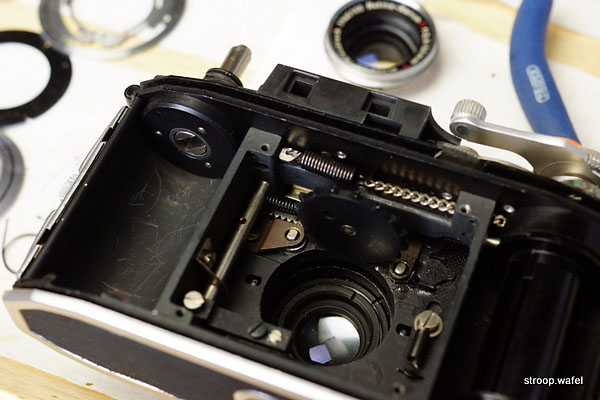
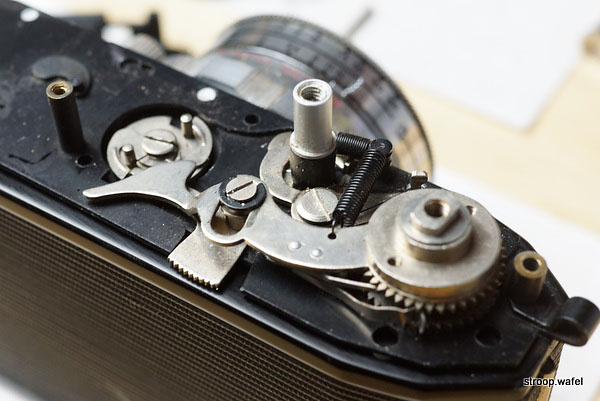
(left) Inside view of a King Regula Cita with inside back plate removed to expose the shutter cocking mechanism. Notice the characteristic chain that pulls a serrated metal rack when the winder is rotated. The cogwheel that transfers this movement to the shutter cocking axel is missing, but was luckily still rattling around inside the camera. The large sprocket wheel is connected to the wind mechanism. (right) Wind mechanism of the Cita with the rangefinder unit removed. The rotation of the sprocket wheel pushes the large lever which activates the double exposure prevention switch and the winder locking mechanism.
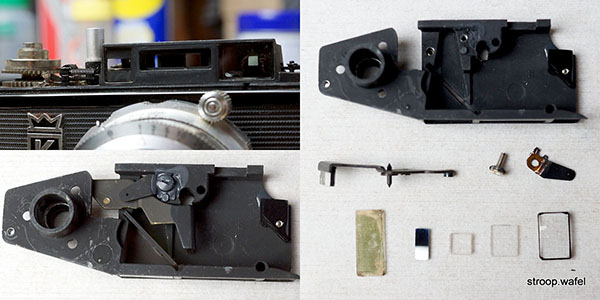
(top left) front view of rangefinder unit with top housing removed; (bottom left) bottom view of rangefinder unit, a small mirror on the left was removed for cleaning/adjusting;(right) disassembled rangefinder unit, the semi-transparent mirror needs recoating.
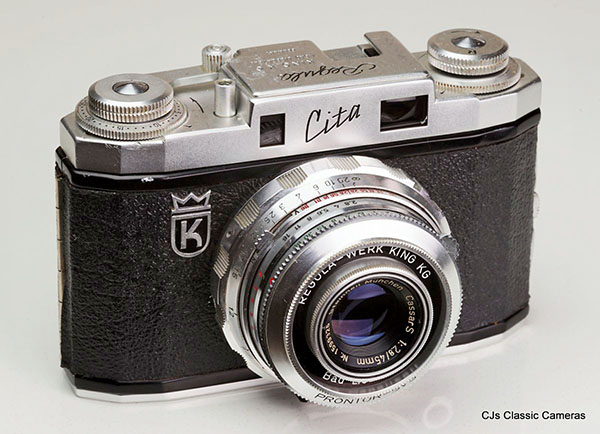
Late production example of the King Regula Cita with Regula III series style lens and faux leather covering instead of the normal herringbone pattern material.
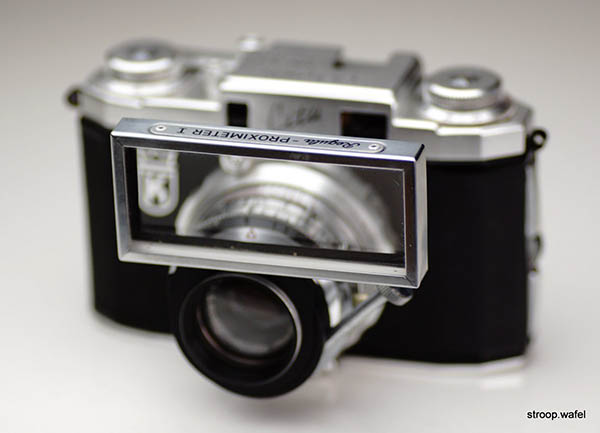
(top left) A rare but fun accessory for the King Regula Cita was the Regula Proximeter. It consisted of a dioptre lens that needed to be placed in front of the camera lens and a rangefinder adjustment lens. It allowed closer focusing than the standard minimum focus distance of the lens while maintaining rangefinder function. Proximeters were made for many cameras, but the Regula Proximeter fits only few models, the Cita pictured above and the Id/IId below, as these were the only models with rangefinders. Lenses of the Regula III series were incompatible with this version of the Proximeter.
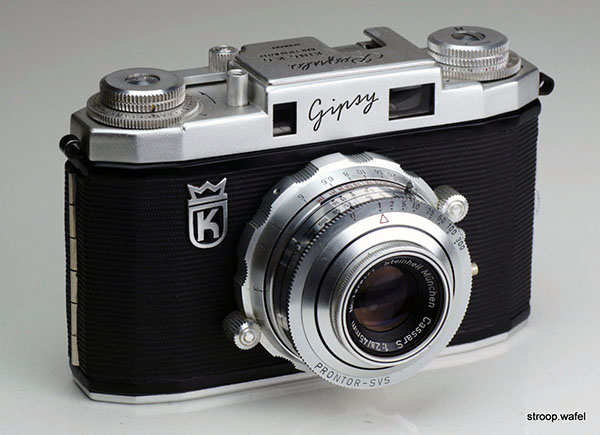
In the U.S.A. the Cita was sold as the Regula Gipsy. It's unclear to me why Gipsy would be a better name or what would be wrong with the name Cita, but that's how it was.
King Regula Citalux 300
The King Regula Citalux 300 was functionally identical to the Regula Cita above, but was finished in gold and read leather. This was not unusual at the time, many brands brought out 'Luxus' models of some of their cameras and these are now highly collectable, but the Citalux is one that is still relatively common to find. There were in fact two versions: a regular one and one with a Regula III series style lens, like the last Regula IP.a show above.
The '300' after the name Citalux is said to have indicated the price of this model in German marks at the time, quite a mark-up over the price of the regular Cita model, which was about DM 180.

A King Regula Citalux 300 with Steinheil Cassar lens . I expected that most of these will have spend all their life in display cabinets but this example actually shows some usage marks.
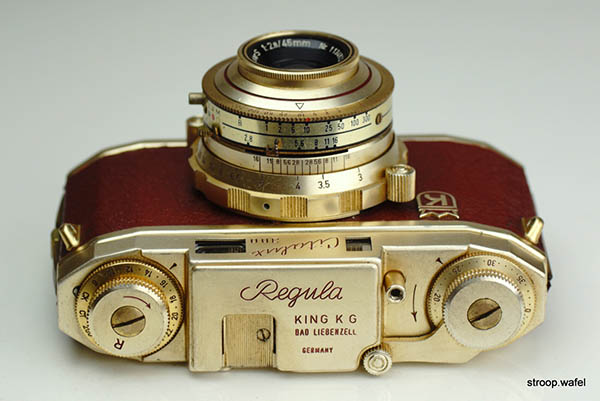
Top view of a King Regula Citalux 300. It certainly had bling factor!
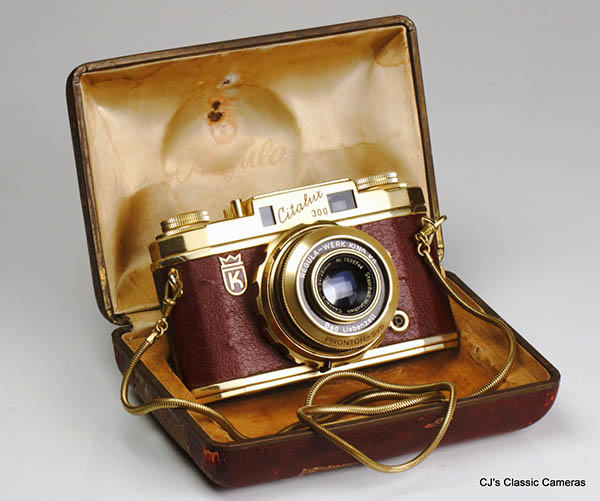
Second version of the King Regula Citalux 300 with Regula III series lens mount and the gold and red velvet case as well as a gold carrying chain they were sold with.
King Regula ID
A rather uncommon version was the King Regula ID (which has nothing to do with the I-D). It had a uncoupled rangefinder; the distance dial was located under the rewind knob instead of the film reminder, which was lacking. One had to get the focus distance with the rangefinder and transfer this value to the focus scale on the lens. The camera also had an extinction meter. The lens was a Steinheil Cassar 45/2.8 and it had a Prontor-SVS shutter.
Update (August 2021): in the last six months I've had three people from Spain contacting me about gold-coloured Regula ID or IID with green herringbone cover, not unlike the Citalux above, all in a small range of serial numbers of around 97,000. I can find no documentation of these, so if you know anything about the history of these cameras, or have one for sale, please get in touch! (via email on front page)
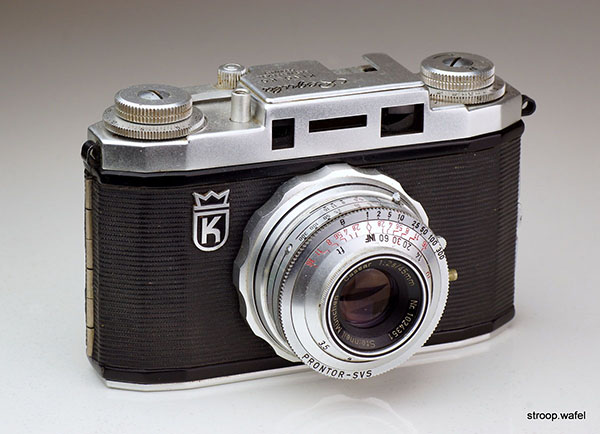
A rather rare King Regula, the ID with uncoupled rangefinder and extinction meter.
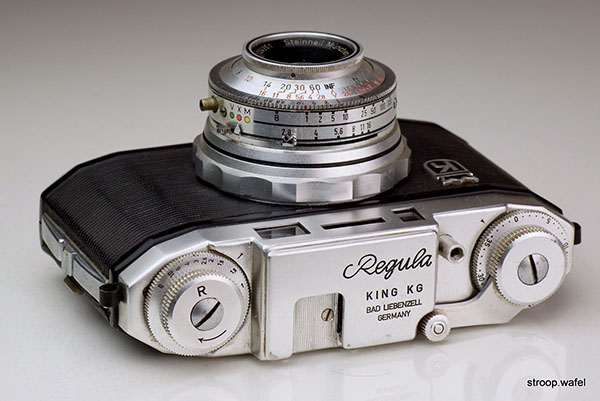
Top view of a King Regula Id. The engravings were a little different from the more common version like on the Cita shown earlier: the name King Regula was moved to the far right and there is no space between Bad Liebenzell and Germany.

Here's a late version of the ID with Regula III style lens. It's marked K6 on the inside, but it has an extinction meter, an f/2.8 lens in Prontor-SVS shutter and an uncoupled rangefinder, i.e., exactly like the ID above. Rare strangely, it is unmarked other than the markings on the lens, so I am not sure this model was sold under the Regula brand or not. These late examples with Regula III lens mounts do occasionally show up (see the I.Pa above), but it is unclear if these were left-over old II series bodies fitted with the new lenses, or some transitional model before the III series were introduced.
King Regula IID
The King Regula IID was similar to the ID but had a Pronto shutter and a 40mm f/3.5 Cassar lens. The King Regula IID therefore compared to the King Regula ID like the King Regula IIa compared to the King Regula IP.a. It appears to be a little more common than the ID. There is a curious version without any engravings on the top housing, a King Regula III series lens and leather covering. Like the unusual IP.a pictured above, it is unclear if this was an official version. As they all have high lens and body serial numbers, perhaps they was made from left-over parts.
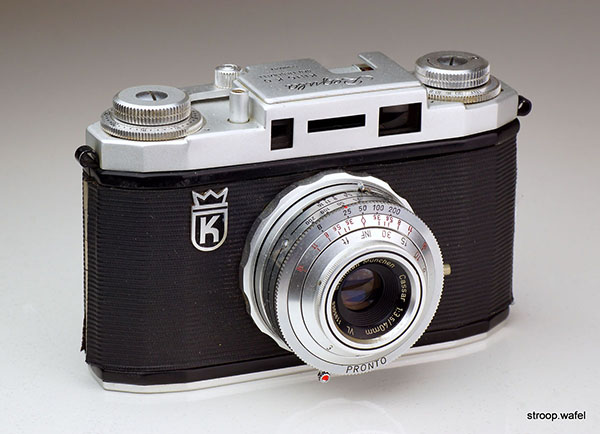
A King Regula IID, which was basically a King Regula IIa but with uncoupled rangefinder.
'Duchess'
The Duchess was essentially a later version of the IP.o, but with a Vero shutter instead of a Pronto, so lacking a selftimer. It had an extinction meter and a fast Cassar f/2.8 lens. The unusual thing about this model is that the name 'Duchess' only appears on the inside. Most rebranded cameras had their names indicated more clearly on the outside of the camera. There's a similar variant with slower 40/3.5 lens and a Pronto shutter marked 'Duke', which is essentially a Regula IIa, and I've also seen a Regula ID marked on the inside as 'Queen'. All appear to have been sold in the USA only, but the details are unknown to me. Interestingly, the Duchess was the same as the USC35 below, also sold in the USA, and no model with the exact specifications of the 'Duchess' was sold in Europe.
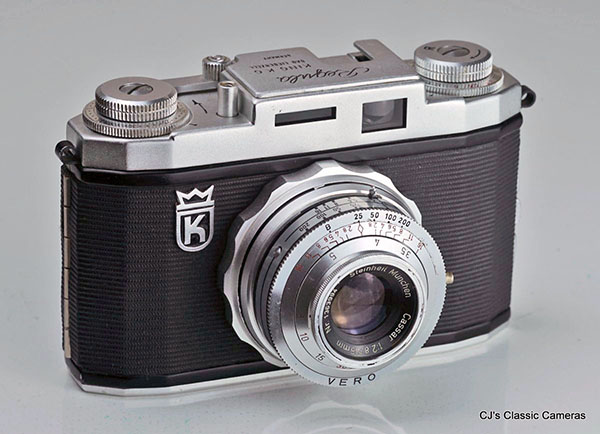
A Regula Duchess with Steinheil Cassar 45/2.8 lens in Vero shutter, similar in specifications to the King Regula IP.o.
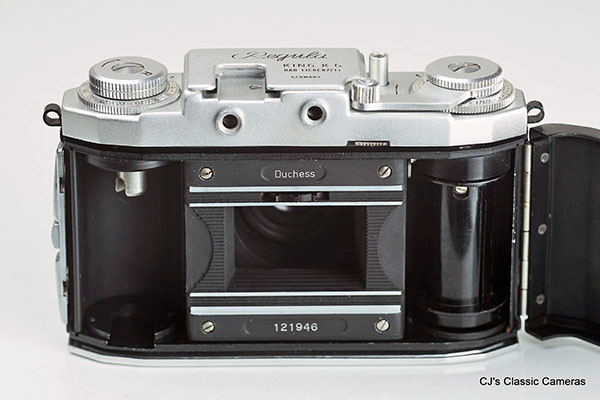
Rear view of the Duchess showing its name above the film frame.
USC 35
The USC 35 was a rebranded King Regula sold by the United States Camera Corporation in Chicago. The USC 35 was essentially the same camera as the 'Duchess' above, but with different markings. There are no indications that show it was made by King Regula-Werk, but it does say it was made in Germany. On the inside it is marked 'K5'.
Not much is known about the United States Camera Corporation, other than that they sold a range of cheap cameras in the 1950s. They also sold the USC35-II, which was similar to the Mastra 35, which you can find in the section on the Regula III series.
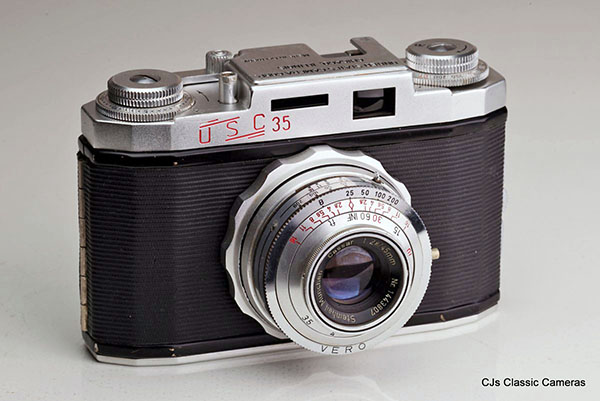
A USC 35 with Steinheil Cassar 45/2.8 lens in Vero shutter, similar in specifications to the King Regula Duchess.

Top view of the same USC 35 showing the name of the company that sold it.
Hapo 36
The Hapo 36 was a rebranded King Regula sold by Hanns Porst, a large German photography shop that sold rebranded cameras under its own name by mail order. The Hapo 36 had an uncoupled rangefinder like the ID but missed the extinction meter. It had a distinctive rectangular metal base plate. There are no markings that indicate it was made by King Regula-Werk, on the inside it is marked K6.
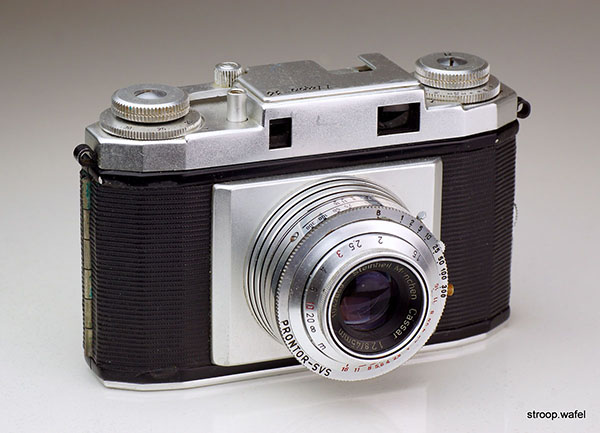
A Hapo 36, similar in functionality to the King Regula ID but without extinction meter.
Tiranty Corvette
The Tiranty Corvette was a camera made by King Regula but assembled in France to avoid import regulations. It was essentially a late Regula IP.a but without the extinction meter and slightly different faux leather covering. The lens was a from the well-reputed Parisian lensmaker Angenieux and was mounted onto an unspecified Compur-style shutter.
The foray of Tiranty into 35mm cameras was not terribly successful, and both the Corvette and the ST280 below are quite rare, even in France. Serial number data suggests a maximum of perhaps 20,000 cameras, including the ST280 below, about equally divided amongst both models. Tiranty was otherwise probably most well known as the French importer of Leica cameras.

A French Regula model, the Tiranty Corvette with Angenieux 45mm f/3.5 lens. Not clearly visible in the picture, the somewhat worn top plate says 'Specialites Tiranty - Made in France'
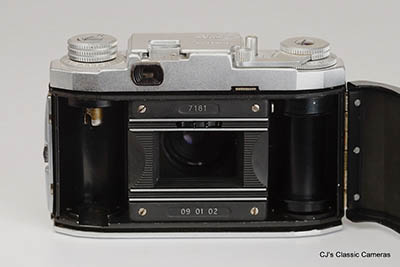
| |
Rear view of the Corvette, which is very similar to its Regula siblings apart from the black framed eye piece. The numbering is also somewhat different, with a serial number where on other Regulas the model designation is, and what I assume is a model nr where on other Regulas the serial# is located. |
Tiranty ST280
Like the Tiranty Corvette above, the 1960 Tiranty ST280 was a camera partially build by King Regula but assembled in France to avoid import regulations. It appears that Tiranty must have had a significant say in the design of this camera, as it is quite different from regular Regula models. It had a completely different top housing with a wide glass panel for view and rangefinder windows, and two small knobs on top (one rewind knob, the other for adjustment of the frame counter) in addition to a wind lever at the back of the camera. The design of the lens mount was similar to that of the late production of the Regula II series (and continued on the Regula III series), but the ST280 had a more convenient focus lever.
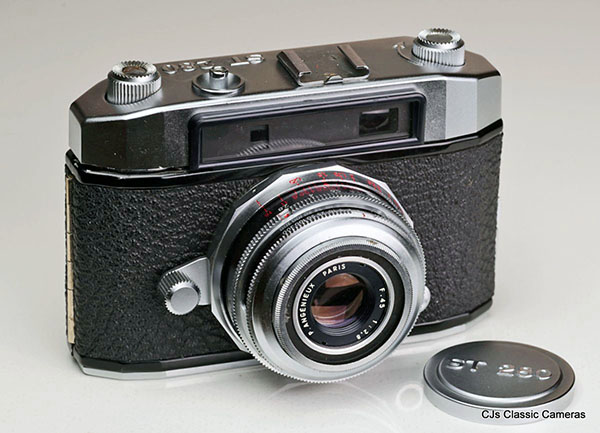
A Tiranty ST280 with Angenieux 45mm f/2.8 lens in an unnamed shutter, but I have seen it being referred to as an ATOS-2. It is a Compur-style shutter, not a Prontor like on almost every other King camera.
The internals of the camera were clearly that of the Regula II series though, and most similar to the Regula Cita with coupled rangefinder. The rangefinder unit is the same, and so is the wind mechanism (other than the wind lever) and most of the rest of the inside of the camera. I think therefore that the camera bodies were supplied by King, and Tiranty added shutter, lens and camera top, knobs and lever. The name, by the way, was presumably derived from the company name (Specialites Tiranty, ST) and the lens aperture (2.8).
The rear of the Tiranty ST280 does not look much like a Regula camera (left), but open the back and its heritage becomes more obvious (right).
Production changes
Several changes were made during production of the Regula II series cameras which applied to all the various models. I have summarised these in the table below, including approximate ranges of serial numbers.
Version | Description | | Serial# |
(Regula IIa, I.Pa, I.Po)
v1a | Ribbled base, King logo engraved in top, Regula name on front. | | 60,000-67,000 |
v1b | Ribbled base, embossed top, King logo at front, Regula name on front. | | 67,000-68,000 |
(Regula I.Po discontinued; Regula Cita, ID and IId introduced)
v2a | (IIa, I.Pa only) Corrugated base, embossed top, King logo at front, Regula name on front. | | 68,000-~103,000 |
v2b | (Cita, ID, IId only) Corrugated base, Regula engraved on top, King logo at front. | | 71,000-~87,000 |
v2c | (Cita, ID, IId; I.Pa and IIa from serial# ~109,000) as v2b but Regula name offset. | | 92,000-146,000 except IIa up till 154,000 |
(Regula Citalux introduced ca. serial# 133,000, Regula ID marked inside as K6)
v3a | (Cita, Citalux, I.Pa, ID, but not IIa) similar to 2c but lens mount changed to that of later Regula III series. | | 146,000-154,000 |
v3b | Leatherette cover instead of herringbone-structured cover. | | 151,700-154,000 |
To summarise, here's a table indicating which models appeared as which versions. Note that this may change if more information becomes available, so if you do have a Regula that does not fit in this table please let me know! Also note that the Citalux 300 had different covering than the other Regulas, so the distinction between v3a and v3b does not apply. In capitals are the versions I have in my collection, still some to go!
| model | v1a | v1b | | v2a | v2b | v2c | v3a | v3b |
| I.Pa | X | X | | X | - | X | - | X |
| I.Po | X | X | | - | - | - | - | - |
| IIa | X | ? | | X | - | X | - | - |
| Cita | - | - | | - | x | X | x | X |
| ID | - | - | | - | X | x | ? | K6 |
| IId | - | - | | - | x | X | - | - |
| Citalux | - | - | | - | - | X | X | - |
As a final remark, the IIa was near the end of the II series production available without extinction meter, i.e., with just a viewfinder, which was located in the centre of the top housing. This model has also been seen with leatherette instead of herringbone cover, but not with series III type lens.
| 
